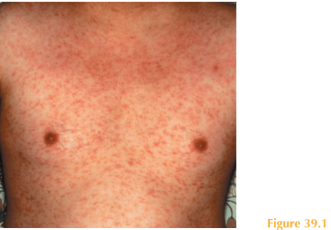History
A 24-year-old fashion design student presents to the accident and emergency department with a 1-week history of feeling unwell with a temperature, abdominal pain, diarrhoea and headaches. Overnight he has developed a widespread asymptomatic rash, mainly over his face and trunk. His college friend was worried about him and brought him to the hospital. The patient reports being previously well although he admitted to having a penile discharge a few weeks previously that had settled spontaneously. He has not trav-elled outside the UK for at least 5 years. He takes no prescription medication but takes occasional vitamin supplements.
Examination
Multiple small erythematous macules and papules were seen over the patient’s face, neck and trunk (Fig. 39.1), with scattered lesions on his limbs. Conjunctivae were unaffected; he had a slightly ‘coated’ tongue but no ulceration in his mouth. Genital examination was normal. He had shotty lymphadenopathy in the cervical region.

Questions
• What investigations would you request?
• What is your differential diagnosis?
• What diagnosis do you suspect and how would you treat him?
Widespread erythematous maculopapular rashes are a sign of a ‘reactive’ process and are usually caused by ‘drugs or bugs’. Antibiotics, NSAIDs, anticonvulsants and thiazide diuretics are amongst the most common medications to result in these eruptions, termed toxic erythema. Viral infections such as measles, Epstein–Barr virus (glandular fever), influenzae infections and acute viral hepatitis may also present with ‘flu-like’ symptoms and this type of non-specific skin eruption.
This patient was diagnosed with a primary human immunodeficiency virus infection (HIV-seroconversion). Approximately 4 weeks after becoming infected with HIV it is estimated that 70–90 per cent of patients develop symptoms that may include general malaise, headache, sore throat, fever, abdominal pain and diarrhoea. Sixty per cent of patients develop an asymptomatic classically morbilliform rash with erythematous mac-ules and papules mainly on the face, neck and trunk. Mouth or genital ulcers may also be present.
A high index of clinical suspicion is needed to make the diagnosis of primary HIV infec-tion as the rash and the symptoms are non-specific. A detailed history of potential risk factors should be undertaken. Symptoms of primary HIV usually start within 4 weeks of a high-risk exposure. Known risk factors include originating from an endemic area, intra-venous drug users who share needles, men who have sex with men, sex workers, people with multiple sexual partners and unprotected sexual intercourse. Vertical transmission from HIV-infected women to the fetus in utero is also a route of spread.
Patients should give consent for an HIV test to look for viral antigen (usually detectable by day 8 using PCR techniques) as well as antibodies (detectable by weeks 2–4). Full blood count may show a lymphopenia and a low CD4 count is frequently seen on T-cell subset analysis.
Treating primary HIV infection with antiretroviral medication is controversial. At present most doctors feel commencement of highly active antiretroviral treatment (HAART) at the time of HIV seroconversion is optional. Many patients presenting at this stage of the disease are being enrolled into large multi-centre trials to see if HAART is effective or not in the short or long term. There is an increasing body of evidence, however, which suggests that HAART may need to be started when the CD4 count drops below 350 cells/ μL, rather than 200 cells/μL as was previously thought.
KEY POINTS
• Primary HIV infection presents with non-specific flu-like symptoms and a maculopapular rash.
• A high index of suspicion and arranging appropriate serological tests are essential to make the diagnosis.
• Always think ‘could this be a primary HIV infection?’ when you see patients with a reactive rash.
need an explanation for this answer? contact us directly to get an explanation for this answer